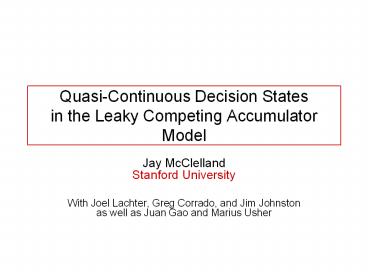Quasi-Continuous Decision States in the Leaky Competing Accumulator Model - PowerPoint PPT Presentation
1 / 37
Title:
Quasi-Continuous Decision States in the Leaky Competing Accumulator Model
Description:
The earlier the pulse, the more it matters ... The Drift Diffusion Model of Choice Between Two Alternative Decisions The DDM is an optimal model, ... – PowerPoint PPT presentation
Number of Views:110
Avg rating:3.0/5.0
Title: Quasi-Continuous Decision States in the Leaky Competing Accumulator Model
1
Quasi-Continuous Decision Statesin the Leaky
Competing Accumulator Model
- Jay McClellandStanford University
- With Joel Lachter, Greg Corrado, and Jim
Johnstonas well as Juan Gao and Marius Usher
2
Is the rectangle longer toward the northwest or
longer toward the northeast?
3
Longer toward the Northeast!
1.99
2.00
4
A Classical Model of Decision MakingThe Drift
Diffusion Model of Choice Between Two Alternative
Decisions
- At each time step a small sample of noisy
information is obtained each sample adds to a
cumulative relative evidence variable. - Mean of the noisy samples is m for one
alternative, m for the other, with standard
deviation s. - When a bound is reached, the corresponding choice
is made. - Alternatively, in time controlled or
interrogation tasks, respond when signal is
given, based on value of the relative evidence
variable.
5
The DDM is an optimal model, and it is consistent
with neurophysiology
- It achieves the fastest possible decision on
average for a given level of accuracy - It can be tuned to optimize performance under
different kinds of task conditions - Different prior probabilities
- Different costs and payoffs
- Variation in the time between trials
- The activity of neurons in a brain area
associated with decision making seems to reflect
the DD process
6
Neural Basis of Decision Making in Monkeys
(Shadlen Newsome Roitman Shadlen, 2002)
RT task paradigm of RT. Motion coherence
anddirection is varied fromtrial to trial.
7
Neural Basis of Decision Making in Monkeys
Results
Data are averaged over many different neurons
that areassociated with intended eye movements
to the locationof target.
8
A Problem with the DDM
- Accuracy should gradually improve toward ceiling
levels as more time is allowed, even for very
hard discriminations, but this is not what is
observed in human data. - Two possible fixes
- Trial-to-trial variance in the direction of drift
- Evidence accumulation may reach a bound and stop,
even if more time is available
9
Usher and McClelland (2001)Leaky Competing
Accumulator Model
- Addresses the process of decidingbetween two
alternatives basedon external input, with
leakage, mutual inhibition, and noise - dy1/dt I1-gy1bf(y2)x1
- dy2/dt I2-gy2bf(y1)x2
- f(y) y
- Participant chooses the most active accumulator
when the go cue occurs - This is equivalent to choosing response 1 iff
y1-y2 gt 0 - Let y (y1-y2). While y1 and y2 are positive,
the model reduces to dy/dt I-lyx II1-I2
l g-b xx1-x2
y2
y1
I1
I2
10
Wong Wang (2006)
Usher McClelland (2001)
11
(No Transcript)
12
Time-accuracy curves for different k-b or l
k-b 0
k-b .2
k-b .4
13
Prob. Correct
14
Kiani, Hanks and Shadlen 2008
Random motion stimuli of different
coherences. Stimulus duration follows an
exponential distribution. go cue can occur at
stimulus offset response must occur within 500
msec to earn reward.
15
The earlier the pulse, the more it matters(Kiani
et al, 2008)
16
These results rule out leak dominance
Still viable
X
17
The Full Non-Linear LCAi Model
y1
y2
Although the value of the differencevariable is
not well-captured by thelinear approximation,
the sign of thedifference is approximated very
closely.
18
Three Studies Related to these Issues
- Integration of reward and payoff information
under time controlled conditions - Gao, Tortell McClelland
- Investigations of decision making with
non-stationary stimulus information - Usher, Tsetsos McClelland
- Does the confidence of a final decision state
vary continuously with the strength of the
evidence? - Lachter, Corrado, Johnston McClelland
19
Timeline of the Experiment
20
Proportion of Choices toward Higher Reward
21
Sensitivity varies with time
22
Three Hypotheses
- Reward acts as an input from reward cue onset til
the end of the integration period - Reward influences the state of the accumulators
before the onset of the stimulus - Reward introduces an offset into the decision
23
Fits Based on Linear Model
24
Fits based on full LCAi
25
Relationship between response speed and choice
accuracy
26
Different levels of activation of correct and
incorrect responses in Inhibition-dominant LCA
Final time slice
errors
correct
27
High-Threshold LCAi
28
Preliminary Simulation Results
29
Three Studies Related to these Issues
- Integration of reward and payoff information
under time controlled conditions - Gao, Tortell McClelland
- Investigations of decision making with
non-stationary stimulus information - Usher, Tsetsos McClelland
- Does the confidence of a final decision state
vary continuously with the strength of the
evidence? - Lachter, Corrado, Johnston McClelland
30
Continuous Report of ConfidenceLachter, Corrado,
Johnston McClelland (in progress)
Expt 1 Probability bias included trial could
end at any time Expt 2 No probability bias
observers terminate trial when they have
determined their best answer
31
(No Transcript)
32
Trial Duration Protocol and performance as a
functionof time for participants groupedby
performance
33
(No Transcript)
34
(No Transcript)
35
Results and Descriptive Model of Data from 1
Participant
36
(No Transcript)
37
(No Transcript)































